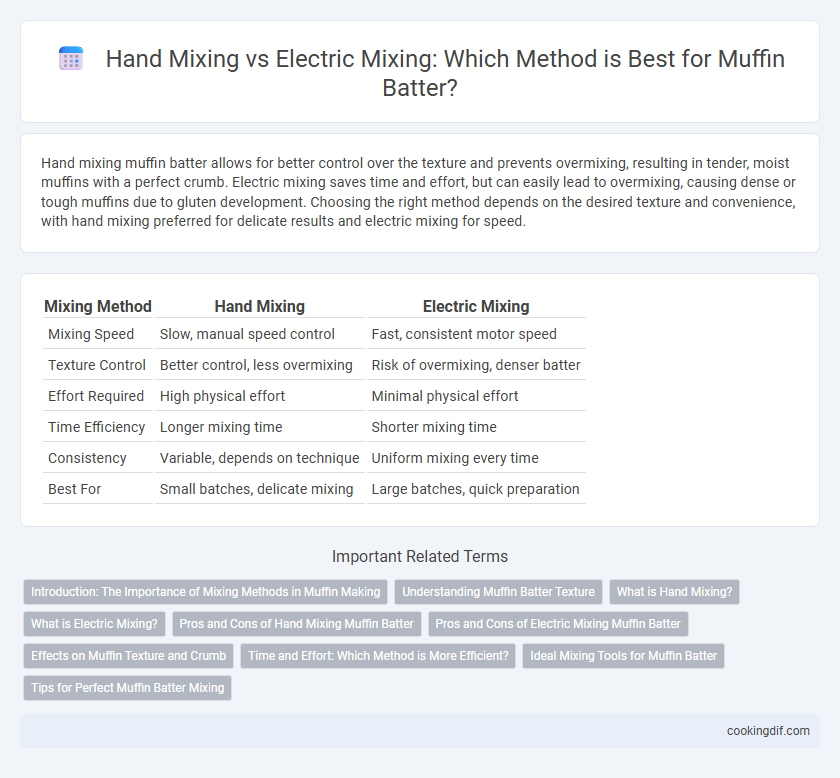Hand mixing muffin batter allows for better control over the texture and prevents overmixing, resulting in tender, moist muffins with a perfect crumb. Electric mixing saves time and effort, but can easily lead to overmixing, causing dense or tough muffins due to gluten development. Choosing the right method depends on the desired texture and convenience, with hand mixing preferred for delicate results and electric mixing for speed.
Table of Comparison
| Mixing Method | Hand Mixing | Electric Mixing |
|---|---|---|
| Mixing Speed | Slow, manual speed control | Fast, consistent motor speed |
| Texture Control | Better control, less overmixing | Risk of overmixing, denser batter |
| Effort Required | High physical effort | Minimal physical effort |
| Time Efficiency | Longer mixing time | Shorter mixing time |
| Consistency | Variable, depends on technique | Uniform mixing every time |
| Best For | Small batches, delicate mixing | Large batches, quick preparation |
Introduction: The Importance of Mixing Methods in Muffin Making
Hand mixing preserves the delicate texture of muffin batter by minimizing gluten development, resulting in moist and tender muffins. Electric mixing, while faster and more efficient, can overwork the batter, leading to dense or tough muffins due to excessive gluten formation. Understanding the impact of mixing methods is crucial for achieving the desired crumb structure and overall muffin quality.
Understanding Muffin Batter Texture
Hand mixing muffin batter tends to create a denser texture with some uneven crumb due to minimal gluten development and less air incorporation. Electric mixing, while faster, can easily lead to overmixing, resulting in tough muffins with tunneling caused by excess gluten formation. Achieving the ideal muffin texture relies on gentle mixing to combine ingredients just until moistened, preserving a tender crumb and light rise.
What is Hand Mixing?
Hand mixing muffin batter involves using a spoon, whisk, or spatula to combine ingredients manually, allowing greater control over the mixing process and preventing overmixing. This method helps maintain the batter's light and airy texture by minimizing gluten development, which can result in dense muffins. Hand mixing is especially beneficial for delicate muffin recipes requiring gentle blending of wet and dry ingredients.
What is Electric Mixing?
Electric mixing uses a powered mixer with rotating beaters or paddles to quickly and evenly combine muffin batter ingredients, ensuring consistent texture and aeration. This method reduces mixing time compared to hand mixing and helps develop the right crumb structure by controlling speed and mixing intensity. Electric mixers often include multiple speed settings, enabling precise control over the batter's consistency for optimal muffin quality.
Pros and Cons of Hand Mixing Muffin Batter
Hand mixing muffin batter allows for better control over the texture, reducing the risk of overmixing, which can lead to dense, tough muffins. It requires no electricity and minimal equipment, making it convenient and quieter for small batches. However, hand mixing can be time-consuming and may result in uneven ingredient distribution compared to electric mixers.
Pros and Cons of Electric Mixing Muffin Batter
Electric mixing for muffin batter offers speed and consistency by thoroughly combining ingredients, reducing the risk of uneven texture. However, overmixing can occur more easily, leading to dense, tough muffins due to gluten development. The convenience and efficiency of electric mixers make them ideal for large batches, but careful monitoring is essential to maintain the desired light and fluffy crumb.
Effects on Muffin Texture and Crumb
Hand mixing muffin batter typically results in a coarser, more irregular crumb due to gentler incorporation of ingredients, preserving air pockets that contribute to a tender texture. Electric mixing, especially at high speeds, can overwork the batter, leading to a denser, tougher texture by developing excess gluten and deflating air bubbles. Careful hand mixing encourages a light, moist crumb profile, while electric mixing requires precise control to avoid negatively impacting muffin softness and fluffiness.
Time and Effort: Which Method is More Efficient?
Hand mixing muffin batter requires more time and physical effort, often ranging from 5 to 10 minutes to achieve a consistent texture, whereas electric mixers can complete the blending process in under 3 minutes with minimal exertion. Electric mixing ensures even incorporation of ingredients quickly, reducing the risk of overmixing and saving energy for other baking tasks. For efficient muffin preparation, especially in larger batches, electric mixers offer significant time and labor advantages over hand mixing.
Ideal Mixing Tools for Muffin Batter
Hand mixing muffin batter using a wooden spoon or silicone spatula provides gentle incorporation of ingredients, preserving the batter's texture and preventing overmixing that can lead to tough muffins. Electric mixers, especially handheld models with a paddle attachment, offer efficient blending but require careful speed control to avoid developing gluten excessively. For ideal muffin batter consistency, hand mixing ensures a tender crumb, while electric mixers are best suited for recipes that demand quick, thorough mixing without compromising texture.
Tips for Perfect Muffin Batter Mixing
Hand mixing muffin batter allows for greater control, preventing overmixing and resulting in a tender crumb, while electric mixers speed up the process but risk developing excess gluten if used excessively. To achieve perfect muffin texture, mix dry and wet ingredients just until combined, with visible streaks of flour accepted, and avoid vigorous stirring. Use a rubber spatula for gentle folding and stop mixing once the batter is moistened to maintain lightness and prevent toughness.
Hand mixing vs Electric mixing for muffin batter Infographic

 cookingdif.com
cookingdif.com